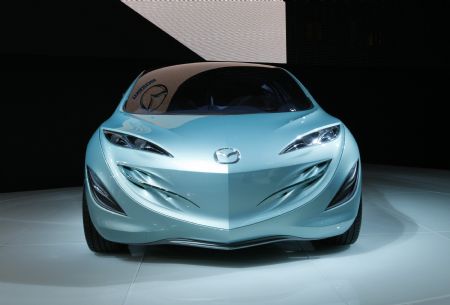Tokyo Motor Show Pushes Environmental Envelope
The 41st Tokyo Motor Show 2009 which opened to the public on Oct. 24 and will run until Nov. 4, is heavily focused this year on next-generation, green-tech vehicles and technology.
Despite the assorted displays and booths only occupying only half the space of the previous show held at the cavernous Makuhari Messe International Convention Center in Chiba City, just outside of Tokyo, Japanese automakers are offering a veritable and industrious display of cutting edge, eco-technology that fuses zero, low-emission and hybrid concepts, with sleek, functional, futuristic and, in some instances, quirky stylings.
|
The Mazda Motor Corp Kiyora urban compact concept car is pictured at the 41st Tokyo Motor Show in Chiba, east of Tokyo October 21, 2009.[Xinhua/Reuters Photo] |
The Concepts
Honda's Skydeck is a sleek, eye-catching, six-seater hybrid vehicle aimed to appeal to a wide range of people of differing ages and lifestyles and effortlessly transcends the barriers between age and style.
Powered by Honda's Motor Assist hybrid technology, the battery is positioned in the center console, running the length of the cabin floor, which allows for unhindered access to the interior that comfortably seats six people. The front doors open and close ' Lamborghini-style' (i.e. vertically) in a scissor-action while the two rear doors slide away.
Also on display from Honda was their CR-Z Concept 2009, a hybrid aimed at making gasoline-electric hybrid cars more accessible, approachable and, in this case much easier on the eye.
Powered by Honda's compact, lightweight and efficient Integrated Motor Assist (IMA) hybrid system, the CR-Z Concept 2009 features a broad, low-slung stance with a short wheelbase, as well as interior styling that is modern, functional, stylish, yet inviting and genial. Featuring an environmentally-friendly powertrain, according to a Honda spokesperson the two-door CR-Z Concept 2009 offers a, "highly responsive and enjoyable driving experience that makes the driver truly feel at one with the vehicle."
Powered by lithium-ion batteries, Toyota's FT-EV II is an electric vehicle designed to carry up to four passengers for short distances and can reach speeds of up to 100 km/h.
 |
|
A model poses on the Honda Motor Co U3-X "personal transporter" electric unicycle at the 41st Tokyo Motor Show in Chiba, east of Tokyo October 21, 2009.[Xinhua/Reuters Photo] |
Toyota's Prius is the quintessential hybrid vehicle that has been in mass-production for years. In fact the third generation Prius topped the best-sellers' list for Japan's automakers this year.
Toyota continues to teach automakers around the globe a thing or two about viable, affordable, eco-technology and has raised the bar this year with its Prius plug-in hybrid concept.
The "ideal combination of an electric vehicle (EV) and a hybrid vehicle (HV)" is how Toyota Motor Corporation describes the Prius plug-in hybrid vehicle (PHV). According to sources at Toyota, this Prius plug-in hybrid concept is its first brand to use a lithium- ion battery as the drive battery -- effectively meaning it can be charged from an external power source such as household electricity.
Due to its lithium-ion drive battery, the successor to its former nickel-metal hydride battery, Toyota has succeeded in increasing the vehicles cruising range.
In comparison with its predecessor, the third-generation Prius' range is 38 km/l while the Prius PHV concept offers at least 55km/ l, which is a significant improvement. By charging from an external power source the cruising range in 'Electric Vehicle Mode' is extended, maximizing the benefits as an environmentally- responsible vehicle. Since the cruising distance as an electric vehicle increases, the benefits to the environment do so commensurately, meaning the techies at Toyota have outdone themselves, once again.
The car has lower CO2 emissions as well as reduced consumption of fossil fuels. Using regular household electricity, the car is fully-charged in 180-minutes at 100-volts and 100-minutes at 200- volts. Fully-charged the Prius PHV in 'Electric Vehicle Mode' has a cruising range of at least 20 km. As with all Prius' the car can function as an EV for short trips and as a hybrid (HV) for longer ones. Besides, its on-board computer will decide all your ' needs vs. efficiency' dilemmas for you -- seriously.
The Suzuki SX4 is a fuel cell concept, which uses 80kW hydrogen fuel cells provided by General Motors. The production-version SX4, however, will make use of a hydrogen tank and capacitor from Suzuki engineering. The hydrogen storage tank compresses gas at 10, 000 psi while the light-weight capacitor, in the absence of a battery pack, evens out the flow of electrons of the 68kW electric motor, which also helps with regenerative braking. Full production details have yet to be released but road tests by Suzuki on its SX4 are underway. Suzuki also showcased a hydrogen-powered ' Burgman' scooter at the Tokyo Motor Show.
Mitsubishi intends to introduce a mass-produced plug-in hybrid to the market by 2013 and the PX-MiEV concept, unveiled at the Tokyo Motor Show for the first time, will most probably get the green light.
 0
0 







